In an interview with Practice.ie Guest Editor, Ann Donnelly, Room 13 Artist in Residence Richard Bracken gives his perspective on the longest established Room 13 studio in the world.
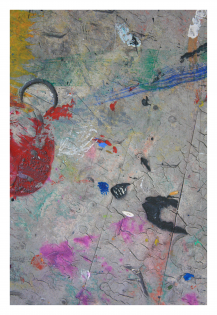
What is Room 13?
Room 13 is a room in Caol Primary School, Fort William. Since 1994 it has operated as an artist’s studio that is shared with and managed by the pupils that use it. From this original studio a worldwide network of Room 13 studios has developed, consisting of creative people of all ages that have embraced the ideas that sprang from Caol Primary School’s Room 13. In 2009, Room 13 International (also based in Fort William) was set up to oversee the development of the growing network.
Tell me a bit about yourself.
I’m Richard Bracken. I studied at Edinburgh College of Art. I’m from Fort William and I was in brief contact with Room 13 pre-college. When I finished college I had the opportunity to work in Room 13 Tomintoul for one year and then I spent six months in Africa on a Room 13 project over there and I’ve been in this one in Fort William for a year. I work within a primary school in a shared studio space. They [the kids] have their own materials and space. My corner is kind of separate but I like to keep it open enough so they can wander over and see what I’m doing. Floor, Room 13
How did you get involved in Room 13?
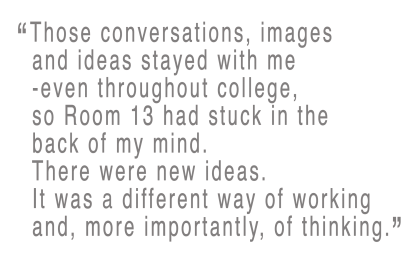 I was invited into Caol as a 17/18 year-old to have a look and chat to Rob Fairley, the artist there. There aren’t that many artists in the Fort William area or they don’t make themselves that visible so I was interested in meeting him. Through a handful of brief visits I was introduced to other aspects of art and artists that I hadn’t been exposed to in High School. Those conversations, images and ideas stayed with me -even throughout college, so Room 13 had stuck in the back of my mind. They were new ideas. It was a different way of working and more importantly, of thinking. I spent the year after college working on a voluntary basis in Room 13 Tomintoul and then I got the opportunity from that to go out to Botswana and work on a Room 13 project for six months. Myself and my partner were both involved. When that came to an end I got the chance to work in Caol. I suppose I showed a level of commitment in terms of time.
I was invited into Caol as a 17/18 year-old to have a look and chat to Rob Fairley, the artist there. There aren’t that many artists in the Fort William area or they don’t make themselves that visible so I was interested in meeting him. Through a handful of brief visits I was introduced to other aspects of art and artists that I hadn’t been exposed to in High School. Those conversations, images and ideas stayed with me -even throughout college, so Room 13 had stuck in the back of my mind. They were new ideas. It was a different way of working and more importantly, of thinking. I spent the year after college working on a voluntary basis in Room 13 Tomintoul and then I got the opportunity from that to go out to Botswana and work on a Room 13 project for six months. Myself and my partner were both involved. When that came to an end I got the chance to work in Caol. I suppose I showed a level of commitment in terms of time.
How does Room 13 work?
I work five days a week roughly during school hours so the studio is available to me 8.30-6. My timetable is flexible and I have very little routine. The studio is available to the kids at break times and lunch-times as a minimum but there are other times throughout the week. I always have to be there for the studio to be open.
I work with P4-7 -that’s 8 or 9 up to 11 -Monday to Thursday. Wee ones on Friday. We’ve worked that out -it’s about whatever suits us. Every Room 13 figures out its own way or working.
There is a wide range of materials. Ideas are developed through talking about them. We have heaps and heaps of paper, paint, all kinds of paint, charcoal, pencils, pens -just a bombsite really -books as well as specialist materials. The kids are actually really excited today -it’s our first day back. They are talking about buying a 3-D printer. A travelling gallery has visited and it showed a sculpture made on a 3-D printer. The kids were amazed. I’ll wait to see how many of them remember it and take it forward. You’re encouraged to aim as high as you like in Room 13.
Would the 3-D printer excite you because you are a sculptor?
It would just be another way to make work in the studio and possibly something we could make money from.
What kind of skills and techniques do you offer -is it always something that is within your comfort zone?
Things come up. Today a girl was just introduced to Andy Warhol. She was then interested in screen-printing so we’ll see how that interest develops. Together the pair of us might start researching the methods as it’s not something that I’m too familiar with -it’s not "me the teacher and you the pupil". When Room 13 started it was heavily into photography. We still do individual portraits before Christmas and class photos as well. It’s been going since 1994 so it’s ingrained. As a new person it was a good way for me to make myself known to staff and to show that the project was up and running again.
Are the teachers ever intimidated by the presence of a resident artist? How do they feel about their own art classes?
There’s still an art teacher that comes to visit. One class has two teachers during the week and one spends time on different art lessons in class too. She’s very happy for me to come and help in class or to allow people to go up to Room 13 to work on specific tasks. The P5 teacher is very keen on allowing a free flow between her class and Room 13 - both the kids going up to Room 13 and me coming down to class. Some teachers might come to me for advice and ideas for art projects in class. So I hope that what I can offer in Room 13 is a parallel and doesn’t replace anything that the school does: it can run alongside it and enhance it.
Who is the long-term relationship with? Pupils? Staff? Location? Organisation?
Officially it’s with the organisation but the need/ desire is driven by the pupils and to a lesser extent the staff. I feel that I have definitely built up a relationship with a good core -there are certain ones come up every day.
When you are trying to build that relationship and children are getting older and moving on how do find that?
I’ve never worked in any Room 13 for more than a year. After one year in Africa we felt like we’d hardly done anything. Even now after a year here I can see how I have grown and the kids too. A year -it’s hardly anything: just a prelude. I really feel that you need the long-term thing -three years, four, five -to achieve all the things that Room 13 has to offer.
How do you know things are working?
When there are questions. When there is more self-motivated behaviour, more confidence, I suppose. Today was quite funny. They came up at lunchtime and took out all the canvases that they had done before and laid them out for critical appraisal. The whole floor was just filled. They had a good fresh look -some of these canvases are from way back. It was a good conversation. One canvas was just red. I think that the artist had planned to do something about it. Some people including the artist thought it was rubbish and others thought there was something about it. But then we talked about Rothko. That’s when it’s working when I can sit back on a comfy seat and let things take shape. There was another canvas done by an adult. It was a sunset with silhouetted hills and water detailed and we started asking: Does it have to be detailed to be a good painting?
We don’t really get asked to measure or appraise. For the day-to-day stuff in my studio there is no funding criteria. The measuring thing is something we’ve talked about. It’s an extremely difficult thing to measure. There is TBWA who sponsor Room 13 in South Africa as part of their corporate social responsibility strategy. TBWA has done some small studies in various bits and pieces.
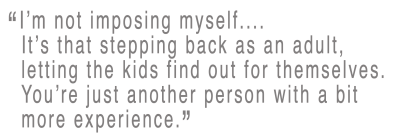 How do you describe what you do, your practice?
How do you describe what you do, your practice?
When someone asks me what do you do? I say I’m an artist in a primary school. I make my own work but I share my space with the pupils of the school. It’s a shared space with an artist working alongside the kids. I’m not just an artist in residence: at the best of times we are working alongside each other -I’m making my work, they are making their work. It’s like being in a shared studio. If they want an opinion -I’ll not always tell a person that their work is wonderful. You’re allowed to say what works and what doesn’t -if it’s asked for.
I’m not imposing myself. It’s a question of knowing when to come in as an adult, when to ask a question. That’s what I’ve taken from the three Room 13’s that I’ve worked in. It’s that stepping back as an adult, letting kids find out for themselves. You’re just another person with a bit more experience.
I’ve heard the Room 13 gets commissioned to make work by galleries and organisations. Are you doing anything like that right now?
We are planning to put together work in November and February in Ullapool and Fort William. We’re going to give everyone a brief and just see how everyone responds. We’ll select the work by a democratic process.
Tell me a bit about the management team.
During my first year the management team has been a flexible entity, with few people with official titles. The group was really just made up of the ones who naturally took it upon themselves to make sure things are done right. We are at the stage now where we are tightening that up and are now voting for additional people to join the team.
How do you set a balance with your own practice?
I have a day set aside where I have no other appointments and I don’t plan anything -on a Thursday -and I concentrate on my own stuff.
Sometimes I’m doing stuff in class as well. It works best if I have one day at least where I say, "I’m busy". Sometimes I have a spare few hours on Wednesday too. It’s very important to keep your own work up, for the kids to see an adult actually drawing because that’s what they do. They’re seeing what I’m doing.
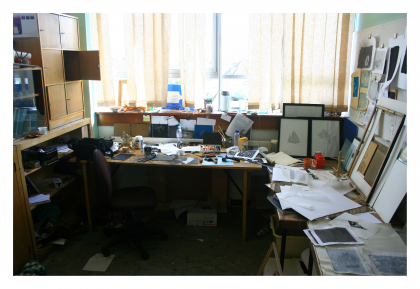
Artist’s workspace, Room 13
Is the content of your artwork affected by the school setting?
My work can be viewed by anyone. It’s very landscape based - rocks and stuff. It’s hard to say just how much my artwork might have been affected by the setting but there are some new drawings I’ve been doing which actually incorporate block paint applied with the same technique a 5 year-old might use. At the moment my work doesn’t involve any imagery which might be seen as inappropriate for a school setting though.
Do you get together with other Room 13 artists to discuss the work or reflect on the process?
Like a peer group? There are four of us as a core of artists here in Fort William and we do meet regularly to have dinner and we are able to discuss ideas related to Room 13. We naturally cross paths throughout the week as we are not that far away in terms of distance. In previous years we have held a Summer School at Strontian, which amongst other things has allowed Room 13 artists from other countries to visit Scotland and exchange ideas. So we are actually part of a much bigger group.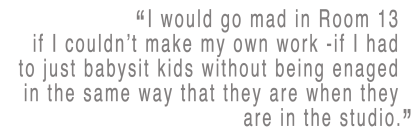
How important is it to the children that you are a practising artist?
I don’t know. It’s funny because certainly the younger ones see me as just another teacher because that’s all they know -an adult in a school is a teacher - but for the older ones they get that there are bits and pieces all over the floor that they can’t stand on and they realise that I am making work. Occasionally we can have a conversation about my work and I can get an opinion. If you were to ask them that question: Does it matter if Richard is a practising artist?....I don’t know. All the adults feel that it’s a part of Room 13.
I would go mad in Room 13 if I couldn’t make my own work -if I had to just babysit kids without being engaged in the same way that they are when they are in the studio. The thing that some people don’t realise is that work is your currency. It’s your CV. If you haven’t made anything in the last ten years for example it becomes very difficult to get opportunities as an artist. I don’t want to be a teacher. I don’t want to be a youth worker. The flip side is similar. I would find it more difficult to justify myself as an artist if I had a studio in my own little shed in isolation. I think I would miss something -but a quiet wee shed would be nice from time to time!
Does Room 13 offer security as an artist?
At the moment, with the position I’m in I have the freedom to develop my work whilst fulfilling my obligations to the wider organisation of Room 13. The work that is produced by the various artists-in-residence is seen as an important part of the whole thing. So making the work is valued and I have a free studio space to work from. It’s a good base to be allowed to grow from. There are also advantages to running workshops and things during weekends or holidays as we are able to run these through Room 13 which has a more established reputation than a younger, individual artist for example. So I think Room 13 offers support -which is a form of security.
What keeps you inspired?
I keep doing this for a number of reasons. One is the fact that Room 13 originated from Fort William. There’s not a lot going for Fort William apart from the surrounding areas beyond the town -it’s not on the map in terms of the arts. The town grew from all the industry -the aluminium smelter and the paper mill -but much of the activity in Fort William has diminished leaving it quiet. The remarkable thing is that Room 13 has grown out of this and has been an idea that has spread globally. In my opinion it is the best thing that has come out of Fort William.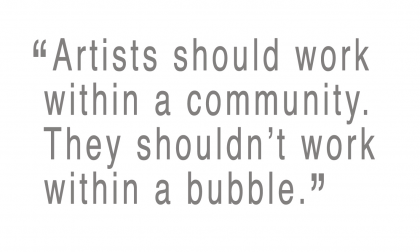
The other thing that keeps me interested in Room 13 is the philosophy. There is so much potential in the way that an artist can work with kids and the way that they can produce work. This isn’t something I envisaged doing when I was at college. When I was at college I hadn’t spoken to any kids at all. I had no idea how I was going to work with young people. Everyone is learning at every level all the time. This is a very unique set-up -it’s not something you will find everywhere and there is potential for it to keep developing, for both parties’ work to be influenced and develop in parallel. Artists should work within a community. They shouldn’t work inside a bubble. For the young people it’s about having another adult -not a teacher or a parent -in the space, which is different.
As an artist you see things and have experiences and interpret them in your own way -things you might walk past every day but you see them differently. This is a good position for an artist to be in. It wouldn’t necessarily work if I was a joiner-in-residence or athlete-in-residence -not knocking either profession -but I believe you can get into any subject through art.
Teachers might work in a school for a long time -that’s not so common with an artist.
It’s a bonus having a particular artist long-term. Every time a new artist comes in the relationship has to be built back up. So there’s definitely a strong argument for the artist staying on. School is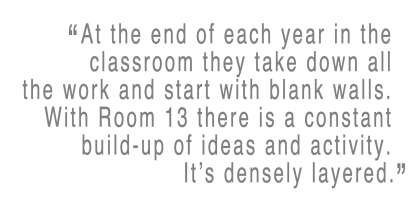 cyclical -they repeat the curriculum each year. Room 13 is more linear. It allows the children and the studio and the artist to keep developing.
cyclical -they repeat the curriculum each year. Room 13 is more linear. It allows the children and the studio and the artist to keep developing.
At the end of each year in the classroom they take down all the work and start each year with blank walls. With Room 13 there is a constant build-up of ideas and activity. It’s densely layered. In here there are canvases that go back to 2001. Some of the kids rake around in the archival stuff -there are boxes with press clippings and other archive material -they gain a sense of where they are in the history of the room. And some of them have an appreciation of that history and what it means.
We get lots of visitors and we have seminar days with people from all over wanting to find out more. It’s good having an in-depth discussion but if you really want to understand Room 13 you need to get over here and see the place to see how everything works. When you see it, it does make a lot more sense. Recently we had a visit from Members of the Scottish Parliament and they chatted to us here in the studio. It was quite an experience -for everyone. Room 13 is energetic. Things are constantly changing.
What can you achieve through this project that you couldn’t achieve through short-term work?
In a nutshell: more of a presence within a community.
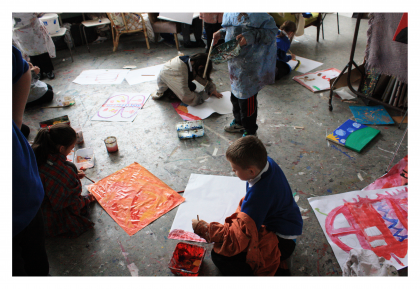
Young artists at work in the studio.


No comments added